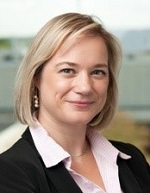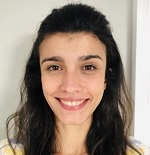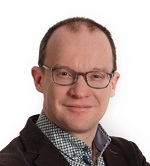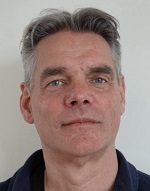First in man clinical trial on salivary gland stem cell transplantation to ameliorate radiotherapy induced xerostomia - PDF Version
By Rob P. Coppes, University Medical Center Groningen (UMCG), The Netherlands
The University Medical Center Groningen (UMCG) in The Netherlands will start the world’s first trial of autologous salivary glands stem-cell transplantation in the of head-and-neck cancer patients who are at risk of a dry mouth after radiotherapy.
In this edition of the Radiobiology Corner, I provide an overview of the breakthroughs that have been made to develop such a therapy from the first idea to the final steps. Some of the many people (>40) who have been involved in some way in the development provide their personal views on their roles in the long journey that we have taken from the fundamental knowledge of stem cells to translation of that knowledge into a clinically applicable method and the upcoming clinical trial.
Severe hyposalivation and consequential xerostomia (dry mouth syndrome) are very common, often irreversible side effects of radiotherapy treatment for head-and-neck cancer. Symptoms are: alterations in speech and taste; difficulties with mastication and deglutition; and increased risk of the development of oral infections and dental caries. Xerostomia severely hampers the quality of affected patients’ lives. Since the 1980s, radiobiology research at UMCG has been aimed at understanding and preventing this nasty side-effect of radiotherapy. When it became clear that radiation-induced hyposalivation was the result of an inability of the tissue’s stem cells to produce enough mature functional cells and that this could be modulated (1), the idea of stem-cell therapy emerged. The fusion in 1998 of the Department of Radiobiology with the stem cell biology group of Professor Gerald de Haan to form the Department of Cell Biology paved the way for my group to investigate that research idea.
One of the pioneers was Isabelle Lombaert, who published in 2008 the first paper on the isolation and culture of mice salivary gland stem cells. She showed that transplantation of these cells could rescue salivary function after irradiation (2).
Dr Lombaert: To see finally our preclinical efforts in stem-cell therapy being brought into the clinic to relieve patients from xerostomia fills me with joy and gratitude. This has been an endeavour in which multiple people from various disciplines have come together to make this happen. I still remember the early days during my PhD training when we provided the first evidence that stem-cell transplantations into irradiated salivary glands of mice regenerated the organ. Increased levels of saliva were observed over long periods post-treatment, on a consistent basis, which indicated that we were restoring the function of the damaged glands. I don’t think I realised the complete impact of these results until we revealed our findings to others in the research field and through patient platforms. Later, colleagues confirmed the feasibility of this approach with human cells and fine-tuned the method for clinical translation. This path to the clinic has been long and time-consuming, but there is no greater satisfaction than being able to help patients. I continue with the design and translation of various therapies to treat xerostomia in the USA, yet this stem-cell-based therapy is one of a kind. I couldn’t be prouder of our initial scientific breakthrough and of everyone who has participated in this effort.

Isabelle Lombaert, PhD
Assistant professor
Department of Biological and Materials Sciences
Biointerfaces Institute, School of Dentistry
University of Michigan, Ann Arbor, Michigan, USA
Dr Lombaert’s work proved the principle and enabled us to obtain several major grants to continue the work. The next two major breakthroughs were published between 2011 and 2016. Lalitha Nanduri showed that salivary gland stem cells could be selected (3,4) and expanded in culture (5); and Martti Maimets, guided by the seminal work of the laboratory of Professor Hans Clevers (Hubrecht Institute, Utrecht, The Netherlands) on intestinal organoids, transformed our culture system to enable the expansion of murine salivary-gland stem cells as organoids (tissue derived structures that resemble organs) (6). Transplantation of cells from these mouse salivary-gland organoids greatly improved the efficacy of the stem-cell therapy and these experiments resulted in recovery of saliva secretion to about 80% of normal (6). The next breakthrough was the translation of this methodology to organoids that were derived from human salivary-gland stem cells (7,8). Sarah Pringle showed that these human cells could rescue salivary-gland function after irradiation in a xenotransplantation model (8).
Dr Pringle: My task when I started my post-doctoral position in 2010 was to begin the transition of the mouse salisphere work into the human context. One of the biggest challenges at that time was the establishment of a reliable ‘self-renewal’ culture technique. This was necessary both to increase numbers of stem-cell/progenitors that would be available eventually for transplantation into patients, and to demonstrate stem-cell-like properties. The success of this phase began with the introduction of matrigel and rho-kinase inhibitors into our culture protocols. I remember the satisfaction of seeing wells full of uniform salispheres, grown from single cells, and being able to maintain them for weeks. Early in this phase, we switched to use of the ‘GentleMACs’ tissue dissociator. This machine seemed to perform miracles at the time, as its use reduced dramatically the amount of time (and of cramping of our hands) that we had to spend manually snipping up biopsy material into small enough pieces for enzymatic digestion. I was also involved in the initial transplantation of human salispheres into the irradiated murine salivary glands, the measurements of saliva, and the tense moments of cutting the transplanted tissues to try to find transplanted cells. Red cells under the fluorescent microscope! Found them!
I continued to work with Professor Coppes’ group later, as a collaborator. It was a joy to watch the tricky completion of all the steps that were necessary to translate this technique for use in the clinic. It was an honour as a scientist to observe the combination of the small and less small contributions of everyone along the way, remembering where they came from, and to see their development into a finished, clinical product.

Sarah Pringle, PhD
Assistant professor
Department of Rheumatology and Clinical Immunology
University of Groningen, University Medical Center Groningen
The Netherlands
The next step was to optimise the culture and to prepare it for potential clinical application. With the help of many, Cecilia Rocchi developed a methodology to freeze, thaw, culture and expand safely the numbers of human salivary-gland stem cells.
Dr Rocchi: I started my journey in adult stem-cell and regenerative medicine research when I did my PhD in Professor Coppes’ group. I have been involved since the beginning of my PhD in the translational side of the project; first, looking at the best way to cryopreserve patient-derived salivary-gland cells, and later, optimising the culture media to maximise the expansion of patient-derived stem/progenitor-like cells. It’s been exciting to be able to see and be part of the bridge between basic and applied science. It was exciting to be part of a team effort that started before I joined the group and is still ongoing. This team effort brought together scientists, technicians, clinicians and pharmaceutical experts to employ good manufacturing practice (GMP) with the goal to develop a safe “product” for patients suffering from radiation-induced hyposalivation

Cecilia Rocchi, PhD
Post-doc
Centre for Regenerative Medicine
Institute for Regeneration and Repair
The University of Edinburgh, Edinburgh, UK
The translation to GMP was a somewhat frustrating part of the project. Every part of the process, from stem-cell isolation and culture to production of the final therapy, had to be re-established to fit GMP. This process involved the solution of many experimental problems and the jumping of many bureaucratic hurdles. It took five years, but was finally achieved with the help of many people such as Coba van Zanten of the Advanced Therapy Medicinal Products laboratory of the UMCG, Anne Jellema, Mirjam Baanstra and many more.
Finally, last month we received the definitive approval of The Netherlands’ Central Committee on Research involving Human Subjects (CCMO) ‑ the “Dutch FDA” ‑ to proceed to the proposed clinical trial. One local bureaucratic issue remains to be resolved. Assuming that no new problem appears, we hope to start the Phase I/II trial this year.
Roel Steenbakkers will be the principal investigator of the trial, which requires the involvement of five departments: Radiation Oncology, Oral Maxillofacial Surgery, Radiology, Biomedical Sciences of Cells and Systems and the hospital pharmacy, with many local specialists.
Dr Steenbakkers: I am a radiation oncologist who specialises in head-and-neck cancer. Every day I see patients who want to be cured of their cancer through the use of radiotherapy. Due to the close proximity of many normal tissues to their tumours, patients experience severe side effects that are caused by unintended co-irradiation of these normal tissues. Xerostomia is the most commonly reported side-effect and has a severe impact on patients’ quality-of-life. For about 40% of patients, xerostomia is a permanent side-effect (continuing >2 years after treatment) and will last for the rest of their lives. The reason for this is that salivary glands are damaged for life by radiation. Although new radiotherapy techniques are emerging, e.g. proton therapy, which enables reduction of the dose of radiation that is imposed on the salivary glands, many patients will continue to face permanent xerostomia. For this reason, it is very exciting that we have developed a method that might restore full function of one of the salivary glands after radiation through transplantation of patients’ own stem cells. This might be a major step in the reduction of this severe side-effect. The translation of basic laboratory research into real clinical practice is a very nice part of this whole project. In addition, for me it is thrilling that salivary-gland stem-cell therapy will be the first stem-cell therapy to be introduced for treatment of a solid organ in humans, and that I am to be the principal investigator of this clinical study that has practice-changing potential.

Dr Roel Steenbakkers
Department of Radiation Oncology
University Medical Center Groningen
University of Groningen
The Netherlands
For me this has been a very interesting journey. We discovered a lot during the years of this work: we learned what and where the stem cells of the salivary glands are, how to isolate them, how to expand their number and how to make them do their job after transplantation in vivo. Now it is up to clinicians to show the real potential of such a therapy. If this therapy works, it will open novel avenues for treatment of other tissues and such treatments will not be limited to the field of radiation oncology. Now we also use stem-cell-derived organoids to study normal tissue (9) and tumour responses to cancer treatment, to study differences in response to different types of radiation such as protons and proton flash, and many more. All in all, it has been a great adventure that has lasted about 20 years.
.jpg.aspx)

Professor Rob P. Coppes
Departments of Radiation Oncology
and Biomedical Sciences of Cells and Systems
University Medical Center Groningen
University of Groningen
The Netherlands
Selection of publications:
- Lombaert IM, Wierenga PK, Kok T, Kampinga HH, de Haan G, Coppes RP. Mobilization of bone marrow stem cells by granulocyte colony-stimulating factor ameliorates radiation-induced damage to salivary glands. Clin Cancer Res 2006;12(6):1804-12.
- Lombaert IM, Brunsting JF, Wierenga PK, Faber H, Stokman MA, Kok T, Visser WH, Kampinga HH, de Haan G, Coppes RP. Rescue of salivary gland function after stem cell transplantation in irradiated glands. PLoS One 2008;3(4):e2063
- Nanduri LSY, Maimets M, Pringle SA, van der Zwaag M, van Os RP, Coppes RP. Regeneration of irradiated salivary glands with stem cell marker expressing cells. Radiother Oncol 2011; 99(3):367-72.
- Nanduri LS, Lombaert IM, van der Zwaag M, Faber H, Brunsting JF, van Os RP, Coppes RP. Salisphere derived c-Kit(+) cell transplantation restores tissue homeostasis in irradiated salivary gland. Radiother Oncol. 2013;108(3):458-63
- Nanduri LSY, Baanstra M, Faber H, Rocchi C, Zwart E, de Haan G, van Os RP, Coppes RP. Purification and ex vivo expansion of fully functional salivary gland stem cells. Stem Cell Reports 2014, 3, 1-8.
- Maimets M, Rocchi C, Bron R, Pringle S, Kuipers J, Giepmans BNG, Vries RGJ, Clevers H, de Haan G, van Os R, Coppes RP. Long-term in vitro expansion of salivary gland stem cells driven by Wnt signals. Stem Cell Reports, 2016, 6, 150-162.
- Feng J, van der Zwaag M, Stokman MA, van Os R, Coppes RP. Isolation and characterization of human salivary gland cells for stem cell transplantation to reduce radiation-induced hyposalivation. Radiother Oncol 2009; 92, 466-471.
- Pringle S, Maimets M, van der Zwaag M, Stokman MA, van Gosliga D, Zwart E, Witjes MJH, de Haan G, van Os R, and Coppes RP. Human salivary gland stem cells functionally restore radiation damaged salivary glands. Stem Cells, 2016;34:640–652.
- Rocchi C, Cinat D, Serrano Martinez P, Jellema AL, Baanstra M, Brouwer U, del Angel Zuvire C, Schepers H, van Os RP, Barazzuol L*, Coppes RP*. The Hippo signalling pathway effector YAP regulates salivary gland regeneration after injury. Science Signaling, in press.